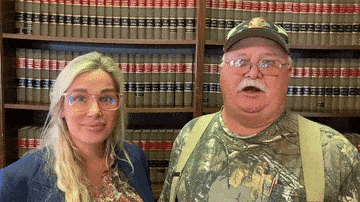“Texas Tough” McKay Law
Texas Structural Defects Injury Lawyer
If you or a loved one have been affected by a structural defect injury in Texas, McKay Law is here to provide the experienced legal support you need. With a deep understanding of Texas laws surrounding structural defects, our firm is dedicated to helping clients overcome the complexities of these challenging cases. We fight tirelessly to ensure your safety, secure justice, and seek the fair compensation you deserve. At McKay Law, protecting your rights and standing up against negligence is our unwavering commitment. Trust us to guide you through every step with skill, compassion, and relentless advocacy.
NO FEES UNLESS WE WIN!
We only get paid when you get paid.
Receive Immediate Medical Care
Get the medical attention you need with no out-of-pocket cost in most cases.
24/7 Access To Us
We are here for you 24/7 so you can focus on healing.
Client Satisfaction
McKay Law has a reputation to be proud of with 300+ 5 star Google Reviews.
Texas Structural Defects Injury Attorney | McKay Law
McKay Law is a leading advocate for individuals injured due to structural defects in Texas, leveraging years of experience in navigating complex construction laws. Their team understands the critical importance of identifying and addressing structural failures caused by negligence, design flaws, or substandard materials. By offering a meticulous approach to case evaluation, McKay Law ensures that every detail is examined, from building codes to contractor compliance. This depth of expertise equips them to build strong cases that protect the rights of their clients and hold responsible parties accountable.
At the heart of McKay Law’s practice is an unwavering commitment to securing justice for those affected by structural defects. The firm passionately fights for fair compensation to cover medical expenses, lost income, and emotional distress caused by unsafe living or working environments. They recognize the devastating impact such injuries can have on victims and their families, and they approach each case with compassion and tenacity. Through clear communication and strategic advocacy, McKay Law empowers their clients, offering them the confidence and support they need during the legal process.
Renowned for their professionalism and results-driven approach, McKay Law has earned a reputation as a trusted legal partner across Texas. Their proactive strategies and understanding of intricate legal frameworks set them apart in the field. Clients appreciate the firm’s relentless pursuit of justice and their ability to negotiate settlements or succeed in court when necessary. McKay Law’s dedication has not only delivered favorable outcomes for their clients but has also reinforced their standing as a reliable advocate in the fight for safer, defect-free structures across the state.
Understanding Structural Defects Injuries in Texas
Structural defects can lead to serious injuries, and understanding the legal and safety implications is crucial. Here’s a quick overview:
What Are Structural Defects?
Structural defects refer to flaws in the design, construction, or materials of a building or structure. These defects can compromise the safety and integrity of the structure, leading to potential injuries or property damage.
Common Types of Structural Defects
- Foundation Issues: Cracks, uneven settling, or poor soil preparation.
- Roofing Problems: Leaks, improper installation, or weak materials.
- Electrical Defects: Faulty wiring or non-compliance with safety codes.
- Plumbing Issues: Leaks, burst pipes, or improper installation.
- Material Failures: Use of substandard or defective materials.
- Design Flaws: Errors in architectural or engineering plans.
Injuries Caused by Structural Defects
Structural defects can lead to various injuries, including:
- Slip and Fall Accidents: Caused by uneven floors, loose tiles, or water leaks.
- Falling Debris: Injuries from collapsing ceilings, walls, or other structural elements.
- Electrical Shocks: Resulting from faulty wiring or exposed electrical components.
- Structural Collapse: Severe injuries or fatalities due to building or structural failure.
Legal Implications in Texas
In Texas, property owners, contractors, and builders can be held liable for injuries caused by structural defects. Key points to consider:
- Statute of Limitations: Texas has specific time limits for filing claims related to construction defects.
- Premises Liability: Property owners have a duty to maintain safe premises for visitors.
- Negligence: Injured parties must prove that the defect resulted from negligence in design, construction, or maintenance.
Steps to Take if Injured
- Seek Medical Attention: Prioritize your health and document your injuries.
- Document the Defect: Take photos, videos, and notes about the defect and the incident.
- Report the Issue: Notify the property owner or manager about the defect.
- Consult an Attorney: A personal injury or construction defect attorney can help you understand your rights and pursue compensation.
Lindsey McKay Takes Texas Structural Defects Injury Cases Seriously
Structural defects in buildings can have catastrophic consequences—ranging from serious personal injuries to devastating property damage. When lives and safety are at stake, the need for a skilled attorney becomes paramount. Lindsey McKay has carved out a reputation in Texas as a dedicated advocate for individuals and families impacted by structural defects. Her deep knowledge of Texas law and unwavering commitment to justice make her the trusted choice for these complex cases.
Understanding Structural Defects and Their Impact
Structural defects often result from poor construction practices, substandard materials, or failure to comply with safety regulations. These defects can compromise the integrity of buildings, leading to incidents such as collapsing roofs, deteriorating foundations, and unstable balconies or staircases.
For the victims, the aftermath of such failures is life-changing. Injuries can include fractures, spinal damage, or even loss of life. Financially, medical bills, lost wages, and long-term expenses add to the burden. For many families, justice feels out of reach without a guiding hand. Enter Lindsey McKay.
Lindsey McKay’s Expertise in Structural Defects Cases
At the heart of Lindsey McKay’s practice is a relentless drive to stand up for those harmed by negligence. She understands the unique challenges that make structural defect cases particularly demanding. Multiple parties, from contractors to architects and material suppliers, may share responsibility. Lindsey’s legal acumen ensures that all liable parties are held accountable.
Her process often involves rigorous investigation, including consulting engineering experts, analyzing building codes, and gathering substantial evidence. This thorough approach enables Lindsey to construct compelling arguments that maximize the chances of victory for her clients.
A Leader in Texas Injury Law
What sets Lindsey apart is her specialization in Texas law. Building codes and liability standards vary significantly across states, and Lindsey’s extensive experience in Texas-specific structural defect cases equips her with unmatched insight.
Texas law, for instance, places considerable importance on understanding statutes of limitations and navigating comparative negligence rules. Lindsey’s attention to detail ensures that clients avoid procedural pitfalls that could jeopardize their claims. This state-specific expertise has been pivotal in securing favorable outcomes, even in high-stakes litigation.
A Record of Results
Lindsey’s track record speaks volumes about her capabilities. Over the years, she has recovered significant compensation for clients, helping them cover medical expenses, secure lost wages, and address long-term care needs. Her success stories stand as a testament to her ability to take on powerful adversaries and win.
Whether negotiating settlements or representing clients in court, Lindsey’s focus remains on achieving justice and delivering peace of mind. Her clients know they are in capable, compassionate hands.
Why Choose Lindsey McKay?
Choosing an attorney is one of the most critical decisions an injured party will make. Lindsey McKay is not just a lawyer; she’s a vigorous advocate for justice. Here’s why so many trust her with their cases:
- Compassionate Advocacy – Lindsey listens to her clients’ stories with empathy, treating them as individuals rather than numbers in a caseload.
- Strategic Planning – Each case is approached with a custom strategy designed to achieve the best possible outcome.
- Proven Results – Lindsey’s history is filled with successful cases and satisfied clients.
- Expert Collaboration – Collaborating with industry experts ensures that her clients’ cases are strengthened with technical precision.
When injuries and structural failures turn lives upside down, Lindsey McKay offers hope and resolution.
Take Action Today
If you or a loved one has been injured due to a structural defect in Texas, you deserve justice—and Lindsey McKay is here to help. She takes each case seriously, fighting tirelessly to ensure her clients receive the compensation they need to regain control of their lives.
Don’t wait until it’s too late. Call Lindsey McKay today to schedule a consultation. During this initial meeting, Lindsey will review the details of your case, explain your legal options, and outline a path forward. Together, you can hold negligent parties accountable and build a safer future for others.
What Are The Most Common Types of Structural Defect Injuries In Texas?
Structural defect injuries can occur when buildings, homes, or other structures are improperly designed, constructed, or maintained. In Texas, where construction and real estate are booming, these types of injuries are unfortunately not uncommon. Here are some of the most common types of structural defect injuries:
1. Slip and Fall Injuries
- Caused by uneven flooring, loose tiles, or poorly constructed staircases.
- Defective railings or missing handrails can also lead to falls.
2. Falling Object Injuries
- Occur when ceilings, light fixtures, or other overhead structures collapse or fall due to poor construction or maintenance.
3. Structural Collapse Injuries
- Entire sections of a building, such as walls, roofs, or balconies, may collapse due to design flaws, substandard materials, or poor workmanship.
4. Electrical Injuries
- Result from faulty wiring, improper installation, or failure to meet electrical codes, leading to shocks, burns, or even fires.
5. Water Damage and Mold-Related Illnesses
- Poor waterproofing, plumbing defects, or roof leaks can lead to water damage, which may cause mold growth and respiratory issues.
6. Foundation-Related Injuries
- Cracked or shifting foundations can lead to structural instability, causing injuries from falls or collapses.
7. Fire Hazards
- Defective fireproofing, lack of fire exits, or improper installation of fire safety systems can lead to severe injuries in the event of a fire.
8. Toxic Exposure
- Exposure to hazardous materials like asbestos, lead paint, or chemical fumes due to improper construction or renovation practices.
9. Glass and Window Injuries
- Poorly installed or low-quality windows and glass panels can shatter unexpectedly, causing cuts or other injuries.
10. Elevator and Escalator Accidents
- Malfunctioning elevators or escalators due to poor maintenance or design defects can lead to serious injuries.
If you’re dealing with a structural defect injury in Texas, it’s important to consult with a legal or construction expert to understand your rights and potential remedies.
What Damages Can I Receive from a Texas Structural Defect Injury Claim?
Structural defects in buildings can lead to serious injuries, emotional distress, and significant financial setbacks for those affected. These defects may arise from poor construction practices, substandard materials, or a failure to adhere to building codes. If you or a loved one has suffered injuries due to a structural defect in Texas, you may have the right to recover damages by filing a personal injury claim.
Damages in such cases can include medical expenses, lost wages, pain and suffering, and even compensation for long-term disability or emotional trauma. Common structural defects that cause injuries include faulty staircases, collapsing roofs, unstable balconies, and foundation issues that compromise a building’s safety.
Taking action to protect your rights is crucial. You should document the defect and any injuries, seek medical care immediately, and consult an experienced personal injury attorney to guide you through the legal process. This guide provides an in-depth look at the types of damages you may be able to claim, the most frequent structural defects leading to injuries, and the essential steps to ensure you receive the compensation you deserve.
Types of Damages You Can Claim
When filing a Texas structural defect injury claim, the law allows for compensation across several categories of damages. These typically fall into three main types:
1. Economic Damages
Economic damages provide compensation for direct financial losses. These are objective costs that can be calculated with documentation. Examples in this category include:
- Medical Expenses
Injuries resulting from structural defects often lead to hospital visits, surgeries, physical therapy, and ongoing treatments. Current and future medical costs can be included in your claim.
- Lost Wages
If you’re unable to work due to your injuries, you may recover compensation for wages lost during your recovery period. Additionally, if the injury results in a long-term inability to work, you may also claim loss of future earning capacity.
- Property Damage
If your personal property was damaged because of a structural failure (e.g., a vehicle in a collapsing garage), these repair or replacement costs can be recovered.
- Out-of-Pocket Expenses
Costs incurred due to the injury, such as transportation to medical appointments or hiring domestic help, may also be recoverable.
2. Non-Economic Damages
Non-economic damages, while intangible, are aimed at compensating for the personal toll the injury has taken on your life. These may include:
- Pain and Suffering
Injuries from structural defects can cause physical pain and discomfort. These damages acknowledge the suffering endured during and after the incident.
Dealing with anxiety, depression, or post-traumatic stress disorder (PTSD) after an accident is common, and compensation for emotional impacts may be included in your claim.
- Loss of Enjoyment of Life
If your injuries prevent you from participating in hobbies or activities you once enjoyed, this loss can be factored into the damages.
- Loss of Consortium
If the injury strains or damages your relationship with a spouse or family members, non-economic damages for loss of consortium may apply.
3. Punitive Damages
Punitive damages are awarded in cases where the responsible party exhibited extreme negligence or intentional wrongdoing. While less common than economic and non-economic damages, punitive damages serve as a financial punishment to deter similar misconduct in the future. For example, a builder knowingly using substandard materials despite clear safety risks could lead to punitive damages.
Examples of Structural Defects in Texas
Structural defects are hazards waiting to happen, and they can arise from a variety of issues. Some common defects and the risks they pose include:
- Faulty Foundations
Cracks or instability in a foundation can lead to uneven flooring or building collapses, which may cause trips, falls, or catastrophic injuries.
- Defective Roofing or Walls
Poor construction may result in roofing collapses or falling debris. These can cause traumatic injuries, particularly in high-traffic areas.
- Inferior Building Materials
When low-quality materials are used to cut costs, structures may fail prematurely, leading to accidents.
- Improper or Substandard Construction Practices
Neglecting safety and industry standards often causes defects that endanger occupants, such as weak staircases or poorly secured balconies.
Documenting Damages for Your Claim
Proper documentation is critical for building a strong case and maximizing your potential compensation. Here are essential steps to document damages effectively:
- Take Photographs and Videos
Document the structural defect and any visible injuries immediately after the incident. Capture the defective area from multiple angles for clarity.
- Preserve Medical Records
Keep copies of all medical diagnoses, prescriptions, treatment plans, and bills. These will help quantify the financial costs of your injury.
- Log All Expenses
Maintain detailed records of all expenses related to the injury, including transportation costs, home accommodations, or medical equipment purchases.
- Gather Witness Statements
If others witnessed the incident, collect their accounts to strengthen your claim.
- Obtain Expert Reports
Structural engineers or contractors can provide evaluations of the defect, which can validate the issue and establish liability.
Why Seeking Legal Assistance is Crucial
Pursuing a structural defect injury claim involves navigating complex laws and processes. Here’s why consulting a qualified legal professional can make a difference:
- Understanding State Laws
Texas law has specific statutes of limitations and liability rules for personal injury claims. An attorney ensures you file within the required time and understand your rights.
- Negotiation Expertise
Insurance companies often try to minimize payouts. A lawyer can negotiate effectively to secure a fair settlement.
- Maximizing Compensation
With their expertise, attorneys can assess the full value of your damages, including future costs and non-economic impacts that you might overlook.
Take the First Step to Protect Your Rights
If you’ve been injured due to a structural defect, it’s important to act quickly. Document your damages, gather evidence, and seek legal advice to ensure you’re fully compensated for your losses. Consulting with an experienced personal injury attorney will help you navigate the process and secure the justice you deserve.
Call to Action
Don’t wait to take action. Contact a trusted Texas personal injury lawyer today to discuss your case and protect your rights. Your path to recovery begins with the right legal support.
The Texas Tough Difference
See why so many others choose McKay Law, PLLC
With over 300 five-star reviews, McKay Law, your local Personal Injury Law Firm has earned the trust and gratitude of our clients. Every case we handle is unique, and every client’s story matters. Don’t just take our word for it—hear directly from our clients about their experiences and why they confidently recommend us to others.
Structural Defects Injury FAQs
A structural defect injury occurs when a person is harmed due to flaws or deficiencies in the design, construction, or maintenance of a building or structure. These defects can lead to accidents such as collapses, falling debris, or unsafe conditions.
Common structural defects include:
- Cracks in walls or foundations
- Uneven or collapsing floors
- Faulty roofing or leaks
- Poorly installed staircases or railings
- Weak or unstable load-bearing walls
Responsibility can vary depending on the situation. It may fall on:
- The property owner
- The construction company
- The architect or engineer
- The manufacturer of defective materials
A legal investigation is often required to determine liability.
If you’re injured, you should:
- Seek medical attention immediately.
- Document the defect and accident scene with photos or videos.
- Report the incident to the property owner or manager.
- Consult a personal injury attorney to understand your legal options.
Yes, you can file a lawsuit if the injury was caused by negligence or a failure to address known structural issues. A personal injury attorney can help you determine if you have a valid case.
Compensation may include:
- Medical expenses (current and future)
- Lost wages or loss of earning capacity
- Pain and suffering
- Emotional distress
- Property damage, if applicable
The time limit, or statute of limitations, varies by state or country. In most cases, you have 2-3 years from the date of the injury to file a claim. Consult an attorney to confirm the deadline in your jurisdiction.
Key evidence includes:
- Photos or videos of the defect
- Medical records of your injury
- Witness statements
- Inspection reports or maintenance records
- Expert testimony from engineers or construction professionals
Yes, tenants can sue landlords if the injury was caused by the landlord’s failure to maintain the property or address known structural issues. Landlords have a legal duty to provide a safe living environment.
To prevent injuries:
- Regularly inspect your property for signs of damage or wear.
- Address repairs promptly.
- Hire licensed professionals for construction or renovations.
- Ensure compliance with building codes and safety standards.






